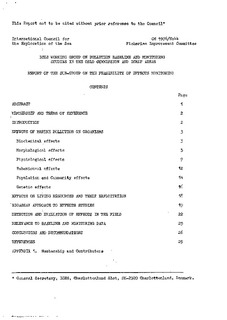ICES working group on pollution baseline and monitoring studies in the Oslo commission and ICNAF areas : Report of the sub-group on the feasibility of effects monitoring
Working paper
Permanent lenke
http://hdl.handle.net/11250/101825Utgivelsesdato
1976Metadata
Vis full innførselSamlinger
Originalversjon
This report is not to be quoted without prior consultation with the General Secretary.Sammendrag
This report first discusses selected recent literature on the effects of pollutants on marine organisms under six headings - biochemical, morphological, physiological, behavioural, population/community and genetic, and examines the ways in which these effects are measured experimentally, including the use of bioassay procedures. It then goes on to consider effects in the light of their potential value in monitoring programmes. While some symptoms could probably be measured in the sea, there woUld in most cases be great difficulty in recognising them as effects of specific pollutants, and in distinguishing pollution - linked from naturally-caused events. This is particularly so in population and community studies and the difficulty in using population-related observations is discussed.
Most behavioural and genetic effects also seem difficult to apply in a monitoring context. However certain biochemical, morphological and physiological effects measured on individuals may be useful, and bioassay procedures are pertinent.
The relevance of existing effects data to current baseline and monitoring programmes is discussed, and it is concluded that effects and monitoring studies cannot easily be linked at present, because whereas monitoring programmes tend to provide information on residues in organisms most effects studies relate effects to environmental concentrations of contaminants. There is an urgent need to link environmental concentrations, body burdens and affects.
In spite of the difficulties it is considered that a start should be made in assessing the possibilies of effects monitoring, and the following four-part approach is suggested.
1. Observations on some or all of the following items should be included in on-going biological survey programmes to begin the building up of a picture of the well-being of organisms in various geographical areas: liver/somatic and gonad/somatic indices; vertebral deformities; tumours, lesions etc; gill damage; general morphology.
2. Since some of the best monitoring data currently available refer to residues in organisms it is suggested that experiments should be conducted to link effects with residues, as well as with levels in the water or sediment, and that monitoring programmes should be designed to include releveant tissues or organs.
3. Sutiable bioassay techniques should be adapted from the wide range of procedures available, to identify regions of poor water quality and to provide a test of the applicability of experimental results to field situations.
4.A number of effects are recognised as potentially useful in monitoring, but none are throught to be sufficiently understood at the present to justify their immediate addition to monitoring programmes. It is suggested however that some of them are worthy of urgent consideration, and that five topics, namely, scope for grwoth, gill damage, vitellogenesis, lysosomal enzymes and steroid metabolism should be subjected to a concentrated research effort for no less than two years (linked via field validation trials to on-going research programmes) to evaluate their use as monitoring tools.
These proposals recognise that for adequate effects monitoring no single procedure will be sufficient in itself, but it is felt that the work outlined above could lead in the short term to a closer association between the chemical and biological data that together are necessary for the identification of areas at risk from pollution, and in the longer term to a suite of techniques for the detection, measurement and evaluation of effects in the field.
Beskrivelse
Contributor: Grim Berge.
